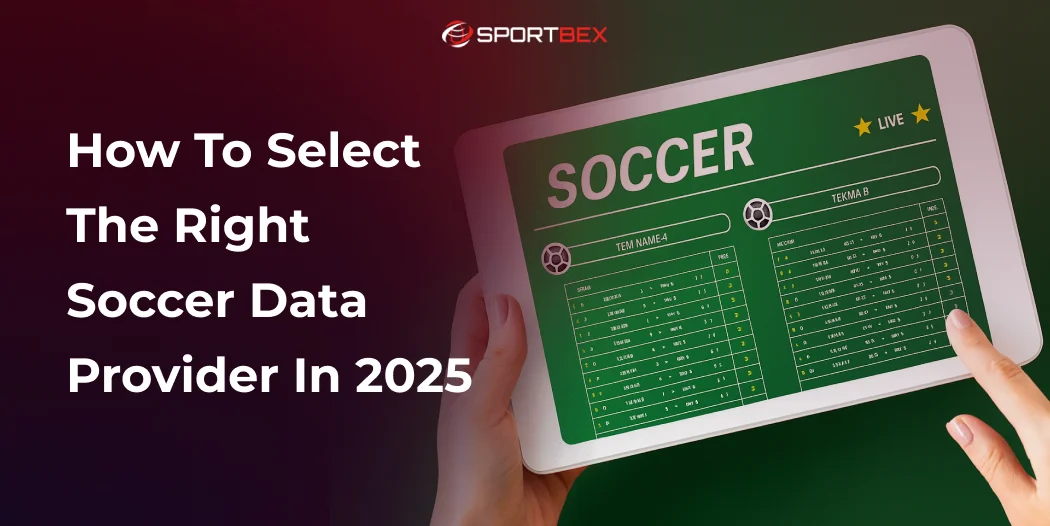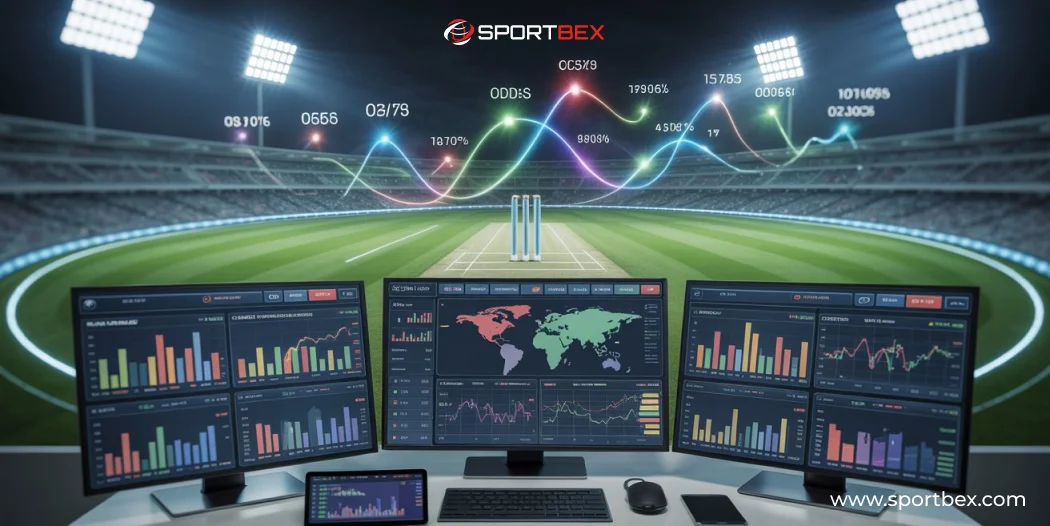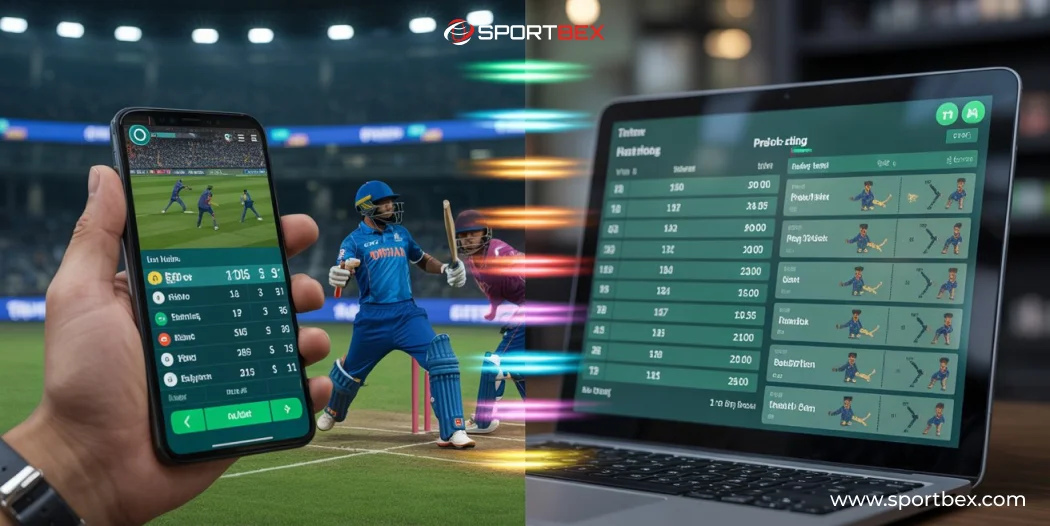Choosing the right soccer data provider can feel overwhelming, but it doesn’t have to be. Start by identifying your needs—real-time updates, player stats, or match analysis? A good provider should deliver fast, accurate data and cover the leagues and tournaments you care about, from local games to international events.
Soccer data APIs power apps, websites, and tools for fantasy football, sports betting, and more. Choosing the right soccer API provider is key to your project’s success. Some APIs offer fast updates but limited coverage, while others provide extensive data but deliver it too slowly.
The soccer data industry has grown rapidly, offering everything from scores to real-time commentary and player insights. With so many choices, it’s crucial to pick a provider that meets your needs and can scale with your project.
This guide will help you avoid mistakes, understand key factors, and make informed decisions. How to Select the Right Soccer Data Provider in 2025 is essential for anyone needing real-time analytics, match stats, or dependable data—whether for business platforms or personal sports projects.
What is a Soccer Data Provider?
A soccer data provider delivers all the football information you need through easy-to-integrate APIs. These APIs send real-time updates on matches, players, teams, leagues, and stats directly to your app. Instead of searching multiple sites or using unreliable data scraping, a soccer API gives you accurate football data in one place.
Top soccer API providers cover leagues and competitions worldwide, from the English Premier League and Spanish La Liga to smaller leagues and international tournaments. Their databases include live scores, player transfers, injuries, and match stats, all updated constantly.
One major advantage of a soccer API is speed. When Messi scores or a red card changes the game, top providers send this info to your app almost instantly—essential for live betting or fantasy sports apps.
These APIs also offer historical data, enabling features like head-to-head comparisons, season stats, or trend analysis. You can access detailed insights, from match results to advanced stats like expected goals (xG), pass accuracy, and heat maps.
Common Issues with Football Data Providers
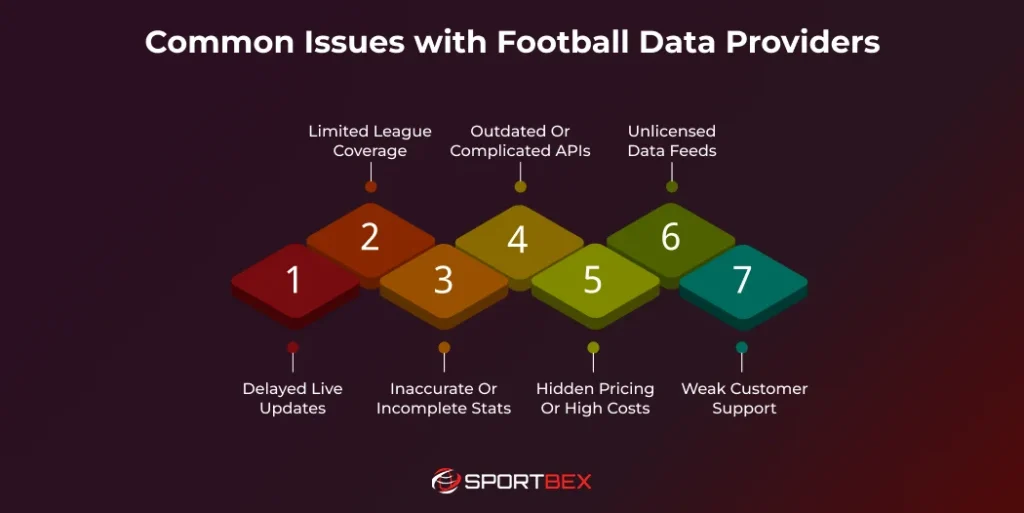
Before we talk about how to choose a football data feed provider, let’s look at a common issue: the problems many soccer data providers have. Knowing these problems will help you ask smarter questions and avoid expensive mistakes!
Delayed Live Updates
Users hate outdated info during live matches, and delays can hurt your app’s reputation. In live betting or fantasy sports, a 30-second delay matters. Some soccer APIs claim to be “real-time” but update every 2-3 minutes, or are fast for major leagues but slower for smaller ones. These delays risk losing customers by delivering goals 3-4 minutes late, damaging user trust.
Limited League Coverage
Imagine this: you start using a football data API that works great for major European leagues. Everything’s fine—until users ask for data on the Brazilian Serie A, Japanese J-League, or local cups, and your provider doesn’t cover them. Most soccer data providers focus on the “big five” European leagues, ignoring other competitions.
Inaccurate or Incomplete Stats
Good data is crucial, but many providers fall short. You might get quick match results, but key details like player ratings, formations, or injury updates are often wrong or missing. Providers sometimes show incorrect lineups, missed goal scorers, or outdated league tables. These mistakes don’t just hurt user experience—they can cause serious legal and financial issues, especially for betting apps.
Outdated or Complicated APIs
Technology evolves fast, but many soccer data providers are stuck in the past! Outdated APIs, messy data, and complicated logins make integration a pain. Developers need simple, reliable APIs with clear docs, clean data, and easy authentication. If you’re spending weeks on an API instead of building features, it’s time to switch providers.
Hidden Pricing or High Costs
Clear pricing is hard to find in the soccer data industry. Many providers use confusing plans with hidden fees, extra charges, or sudden price hikes. Some offer cheap starter plans but push costly upgrades as you use more data. Others split costs by data type, making fees unnecessarily complex.
Unlicensed Data Feeds
Many developers overlook this! Not all soccer data providers have proper licenses from leagues and organizations. Using unlicensed data can lead to legal trouble. Licensed providers offer accurate, reliable data thanks to official partnerships, ensuring better quality and coverage for your business.
Weak Customer Support
When your data feed breaks, you need fast, reliable support. Unfortunately, many soccer data providers offer poor customer service with slow replies and generic answers. Critical API issues require real solutions from experts who understand soccer data and APIs. Without proper support, small issues can quickly disrupt your operations.
How to Choose the Right Soccer Data Provider in 2025
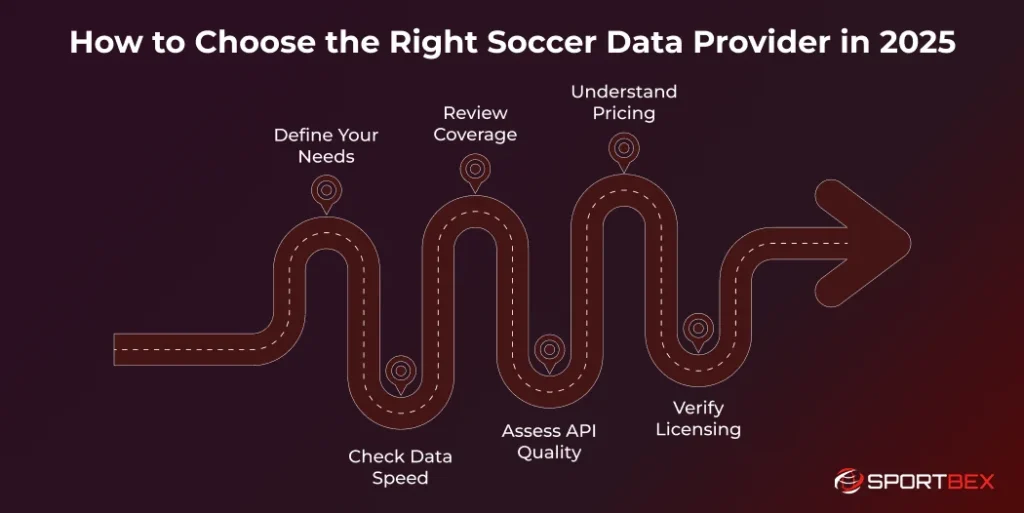
Now that we’ve looked at common mistakes, let’s go through a simple step-by-step guide to help you choose the right soccer data provider for your project. This process will make it easier to compare options and pick the best one.
Step 1: Define Your Needs
Before researching providers, define your needs to save time. List the data your app requires—match results, league tables, stats, or live commentary. Choosing the right sports data API depends on what type of coverage your app needs: which leagues matter most? Focused coverage of key leagues is better than spread-out average data. Lastly, consider your audience—do they follow European football, or do you need data from other regions like Asia or South America?
Consider update frequency. Real-time updates are crucial for live apps, while daily updates may suit analysis tools. Think about your users and how they’ll use the data. Finally, set a budget. Know what you can spend, but remember, the cheapest option may cost more if it doesn’t meet your needs.
Get Your Soccer Data Here
Live scores, player stats, and team data from one simple API.
Step 2: Check Data Speed
Data speed is key for live apps. Don’t just take a provider’s word for it—test their performance during live games. Watch how fast they update events like goals or cards in big matches with heavy traffic. Try test integrations to see how they perform in real time.
Consistency matters as much as speed. A provider that updates in 15 seconds but sometimes takes 5 minutes is less reliable than one that always takes 45 seconds. Users notice delays and get frustrated. Test all updates, not just scores. If your app relies on stats, player ratings, or tactical changes, make sure the provider delivers these quickly too.
Step 3: Review Coverage
The best soccer data providers offer detailed and reliable information. Start by listing the leagues and tournaments your app needs now and in the future. Don’t just count leagues—check data quality. Some providers only offer basic results, while others include detailed stats like player performance, team lineups, and match events. Make sure they also cover playoffs and cups, as this can vary.
For big events like the World Cup or European Championships, pick a provider with experience. Think about season schedules too—European leagues run from August to May, but others are different. If you need data all year, choose a provider with consistent coverage across seasons and regions.
Step 4: Assess API Quality
A good Soccer API makes development easy, but a bad one can cause problems. Look for modern APIs that are simple to use, with clear endpoints, clean data, and helpful documentation.
The best ones let you test in your browser and provide clear examples. Security is important too—choose APIs with API keys, rate limits, and usage tracking. Stay away from outdated systems with poor monitoring or messy data.
Step 5: Understand Pricing
A good soccer data provider should have clear pricing. Look for one that explains costs, usage limits, and extra fees upfront. Some charge per API call, while others bill based on leagues, number of matches, or monthly data usage.
Watch for hidden fees like setup costs, charges for historical data, or advanced stats excluded from basic plans. Cheaper options may seem appealing, but spending more on accurate data, fast updates, and reliable support can save you time and money in the long run.
Step 6: Verify Licensing
Licensing might not be exciting, but it’s essential for legal protection and accurate data. A good soccer data provider should have official agreements with groups like FIFA, UEFA, or national leagues. Always ask for proof—trustworthy providers will gladly share it.
Watch out for providers using “public data” since proper stats and league info usually need licensing. Licensed data is also more reliable because it comes straight from official sources, not random websites.
Why Choose Sportbex as Your Soccer Data Provider
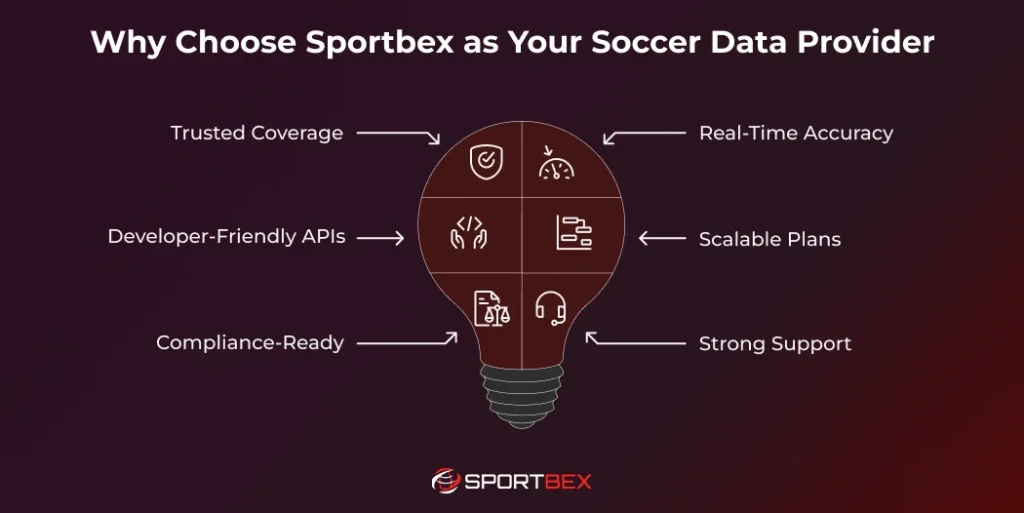
After testing many soccer data providers over the years, I’m excited to say Sportbex is a great choice for 2025 and beyond! As an affordable sport data provider, they solve common issues we’ve talked about and offer new features that make working with their data even better.
Trusted Coverage
Sportbex covers 200+ leagues and competitions worldwide—from top Soccer Leagues like the Premier League and La Liga to lower divisions and international tournaments like the World Cup. Whether it’s a major club or a smaller team, you’ll get detailed, reliable data to power apps for every fan.
Real-Time Accuracy
Sportbex delivers fast and accurate data, updating within 10–15 seconds of real events—even during busy times like Champions League finals or World Cup matches. As one of the most reliable Soccer APIs for Real-Time updates, they stand out by ensuring high quality, with systems that catch and fix errors before the data reaches your app, giving you a consistent and trustworthy user experience.
Developer-Friendly APIs
The Sportbex API documentation is clear, detailed, and easy to use. Built with a RESTful design, it uses JSON responses and logical endpoints. Test API calls in the interactive docs and experiment safely in the sandbox. This developer-friendly setup saves time and simplifies integration and maintenance.
Scalable Plans
Sportbex keeps pricing simple and transparent—no hidden fees. Starter plans are perfect for small projects, while enterprise plans offer flexibility for larger needs. With usage-based pricing, you only pay for what you use. Clear tracking tools make it easy to monitor and manage your data, so you always know what to expect.
Compliance-Ready
Having the right licenses keeps your business safe from legal trouble and gives you peace of mind. Sportbex works with major leagues and organizations to make sure its data feeds are fully licensed. Plus, its systems follow international rules for data privacy and security.
Strong Support
Sportbex customer support knows soccer and technology! Their team includes developers who can help with integration, fixing issues, and optimizing APIs. They usually respond within hours, and the support is always top-notch. For real-time data and live apps, this kind of support is a must.
Conclusion
Delivering real-time match updates, team performance insights, and live player statistics is crucial for any sports platform. That’s why Soccer Score API integration plays a vital role in ensuring your app or website delivers accurate, up-to-the-minute data that keeps users engaged and informed.
Test providers and ask about their coverage, licensing, and features. In 2025, soccer data is evolving quickly, so choose one that prioritizes quality, developer experience, and comprehensive coverage. Reliable data means a better experience for your users.
Whether you’re creating a fantasy app, analytics tool, or fan platform, soccer data is the foundation. Choose wisely. Ready to upgrade? Find out how the right football API can make all the difference.
All Your Soccer Data in One Place
Build your platform on reliable data with our 99.9% uptime guarantee
Frequently Asked Questions
A soccer data provider is a company or service that supplies real-time and historical football data, such as live scores, match events, player statistics, team standings, and fixtures. This data is typically delivered via APIs and used by apps, websites, fantasy platforms, and sports media.
In 2025, users expect instant updates during live matches. Real-time soccer data enhances user engagement, drives retention, and powers features like live scoreboards, fantasy points, and in-game analytics. A delay of even a few seconds can negatively impact the experience.
Yes. Most soccer data APIs are RESTful or WebSocket-based, making them compatible with mobile (iOS/Android) and web platforms. Many providers also offer SDKs or libraries in popular languages like JavaScript, Python, and Swift to simplify integration.
Yes, Sportbex provides a developer-friendly sandbox or free trial so you can test API speed, data depth, and integration ease before committing to a paid plan. This allows you to evaluate the platform risk-free.
Top-tier soccer data providers update data in real time—often within 1 to 5 seconds after an event occurs. Updates include goals, cards, substitutions, injuries, and more.
Recent Blog
Cricket Betting Market Size, Share, Trend and Forecast
November 4, 2025
 13 min
13 min
Live Betting vs Pre-Match Betting: What’s the Difference?
November 4, 2025
 9 min
9 min


